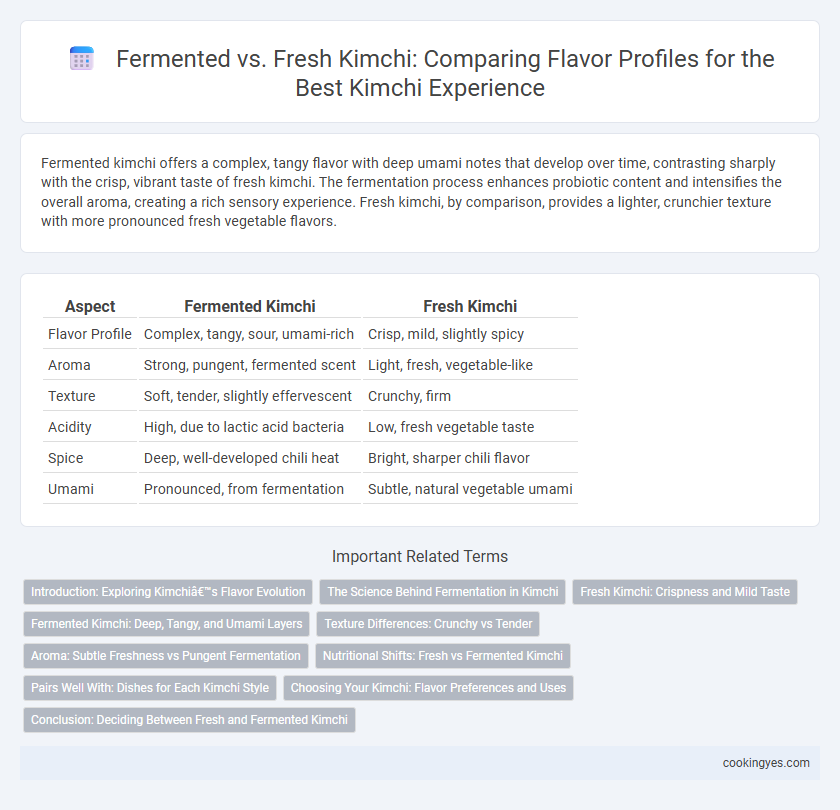Fermented kimchi offers a complex, tangy flavor with deep umami notes that develop over time, contrasting sharply with the crisp, vibrant taste of fresh kimchi. The fermentation process enhances probiotic content and intensifies the overall aroma, creating a rich sensory experience. Fresh kimchi, by comparison, provides a lighter, crunchier texture with more pronounced fresh vegetable flavors.
Table of Comparison
| Aspect | Fermented Kimchi | Fresh Kimchi |
|---|---|---|
| Flavor Profile | Complex, tangy, sour, umami-rich | Crisp, mild, slightly spicy |
| Aroma | Strong, pungent, fermented scent | Light, fresh, vegetable-like |
| Texture | Soft, tender, slightly effervescent | Crunchy, firm |
| Acidity | High, due to lactic acid bacteria | Low, fresh vegetable taste |
| Spice | Deep, well-developed chili heat | Bright, sharper chili flavor |
| Umami | Pronounced, from fermentation | Subtle, natural vegetable umami |
Introduction: Exploring Kimchi’s Flavor Evolution
Fermented kimchi develops a complex, tangy flavor with deep umami notes due to the probiotic bacteria breaking down sugars and vegetables over time. Fresh kimchi offers a crisp, vibrant taste with sharper, more pronounced vegetable flavors and spice intensity. The evolution of kimchi's flavor profile highlights the transformative impact of fermentation on texture and taste.
The Science Behind Fermentation in Kimchi
Fermentation in kimchi transforms fresh cabbage and seasonings into a complex flavor profile through the action of lactic acid bacteria, which produce organic acids, carbon dioxide, and flavor-enhancing compounds. This biochemical process lowers pH, creating a tangy, sour taste and enhancing umami by breaking down sugars and proteins into amino acids and peptides. The dynamic microbial activity during fermentation also contributes to the characteristic aromatic and textural changes that differentiate fermented kimchi from its fresh counterpart.
Fresh Kimchi: Crispness and Mild Taste
Fresh kimchi offers a vibrant crispness and a mild, refreshing taste that highlights the natural flavors of napa cabbage and radishes. The fermentation process is minimal, allowing the vegetables to retain their crunch and subtle sweetness, making it an ideal choice for those who prefer a less pungent flavor. This fresh variety delivers a balanced, palate-pleasing experience that enhances dishes without overwhelming them with acidity or spice.
Fermented Kimchi: Deep, Tangy, and Umami Layers
Fermented kimchi develops a complex flavor profile characterized by deep, tangy, and umami-rich layers resulting from lactic acid bacteria activity during fermentation. The fermentation process enhances acidity and creates a balanced interplay of savory and slightly sour notes, intensifying the overall taste experience. These nuanced flavors distinguish fermented kimchi from its fresh counterpart, making it a staple ingredient in Korean cuisine renowned for its probiotic benefits and robust palate.
Texture Differences: Crunchy vs Tender
Fermented kimchi develops a tender texture as lactic acid bacteria break down the cabbage fibers, resulting in a softer, more pliable bite that enhances its tangy, umami-rich flavor. In contrast, fresh kimchi retains a crisp, crunchy texture due to the intact cell walls of the fresh vegetables, offering a refreshing crunch that complements the initial spicy and salty notes. The contrasting textures between crunchy fresh kimchi and tender fermented kimchi create distinct eating experiences that highlight different stages of fermentation and flavor development.
Aroma: Subtle Freshness vs Pungent Fermentation
Kimchi's aroma varies significantly between fermented and fresh versions, with fresh kimchi exhibiting a subtle freshness characterized by crisp, vegetal notes. Fermented kimchi develops a pungent aroma due to lactic acid bacteria producing distinct sour and umami compounds during fermentation. This transformation enhances complexity, making the scent more intense and layered compared to the mild, green freshness of freshly prepared kimchi.
Nutritional Shifts: Fresh vs Fermented Kimchi
Fermented kimchi exhibits enhanced levels of probiotics such as Lactobacillus, which improve gut health and digestion compared to fresh kimchi. The fermentation process increases bioavailability of vitamins like B12 and C while reducing sugar content and enhancing antioxidant properties. Fresh kimchi retains more raw nutrients and textures but lacks the enriched probiotic content and complex flavor profile developed during fermentation.
Pairs Well With: Dishes for Each Kimchi Style
Fermented kimchi develops a robust, tangy flavor that pairs exceptionally well with rich dishes like Korean BBQ, stews, and grilled meats, enhancing savory notes with its complex umami. Fresh kimchi offers a crisp, mildly spicy flavor ideal for lighter pairings such as salads, seafood dishes, and rice bowls, providing a refreshing contrast. Selecting the right kimchi style amplifies the overall dining experience by complementing the texture and intensity of accompanying foods.
Choosing Your Kimchi: Flavor Preferences and Uses
Fermented kimchi offers a rich, tangy, and complex flavor profile with a pronounced umami depth ideal for enhancing stews, soups, and rice dishes. Fresh kimchi provides a crisp, vibrant, and mildly spicy taste perfect for salads, sandwiches, or as a refreshing side dish. Selecting between fermented or fresh kimchi depends on desired intensity and culinary application, balancing sourness and texture to complement specific recipes.
Conclusion: Deciding Between Fresh and Fermented Kimchi
Fresh kimchi offers a crisp texture and a bright, tangy flavor ideal for those who prefer mild fermentation notes. Fermented kimchi develops a deeper umami richness and complex sourness, enhancing dishes with robust probiotic benefits. Choosing between fresh and fermented kimchi depends on desired taste intensity and digestive health preferences.
Fermented vs Fresh for kimchi flavor profile Infographic

 cookingyes.com
cookingyes.com